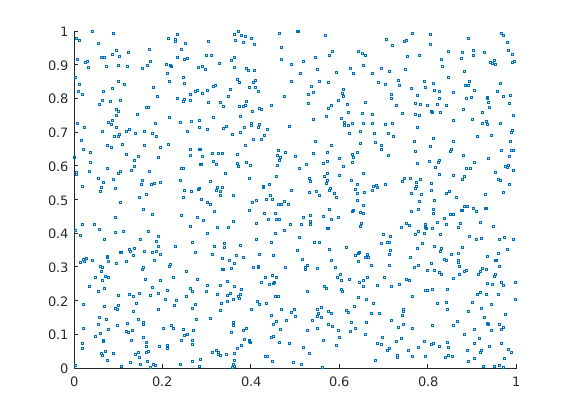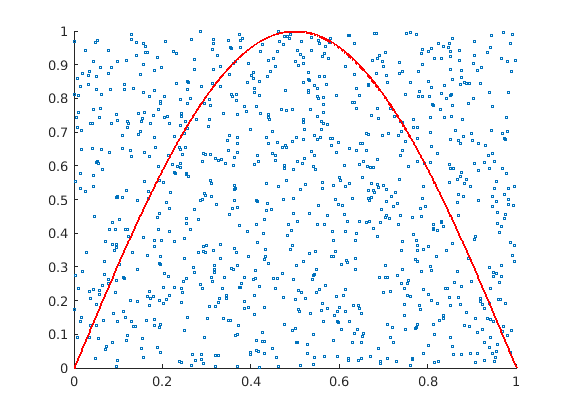Simulation of continuous probability densities
Contents
Plot of random points in the unit square
I'll plot 1000 random points in the unit using the command scatter to plot the points. If I give the command scatter(x,y) the points will be fairly large. So I'll give a third argument, designed to make them large enough to see but not too large.
n=10^3 x=rand(1,n); y=rand(1,n); scatter(x,y,3)
n =
1000

Plot of random points and a curve
I'll plot again, adding the curve  to the plot. I'll use the plot command to plot it, after creating a vector X of points at which to plot it.
to the plot. I'll use the plot command to plot it, after creating a vector X of points at which to plot it.
n=10^3 x=rand(1,n); y=rand(1,n); scatter(x,y,3) hold on X = 0:0.001:1; plot(X,sin(pi*X),'r','LineWidth',2) hold off
n =
1000

Monte Carlo simulation
This is used to estimate an integral. Here I use it to estimate the integral of sin(pi*x), 0<x<1.
n=10^6 x=rand(1,n); y=rand(1,n); a = sum(y<sin(pi*x))/n
n =
1000000
a =
0.6370
I'll compare this with the actual integral. I want to calculate that symbolically, so I first introduce a symbolic variable, t.
syms t b = int(sin(sym('pi')*t),t,0,1)
b =
2
----
pi
which is approximately
double(b)
ans =
0.6366
so the difference is approximately
double(b-a)
ans = -3.4723e-04
We could even use this to approximate  , since
, since  .
.
piapprox = 2/a
piapprox =
3.1399
Approximating  using Monte Carlo simulation
using Monte Carlo simulation
Let E be the circle of radius  , center
, center  ,
,  . I use Monte Carlo simulation to estimate the area.
. I use Monte Carlo simulation to estimate the area.
Important note
Because x and y are n component vectors, I have to use .^2 instead of ^2 to square each component. Similarly, to multiply or divide vectors component by component, you have to use .* or ./
n=10^6 x=rand(1,n); y=rand(1,n); a = sum((x-1/2).^2+(y-1/2).^2<1/4)/n
n =
1000000
a =
0.7851
The actual area is  .
.
pi/4
ans =
0.7854
The error is very small. This gives us an estimate for  .
.
piapprox = 4*a
piapprox =
3.1403